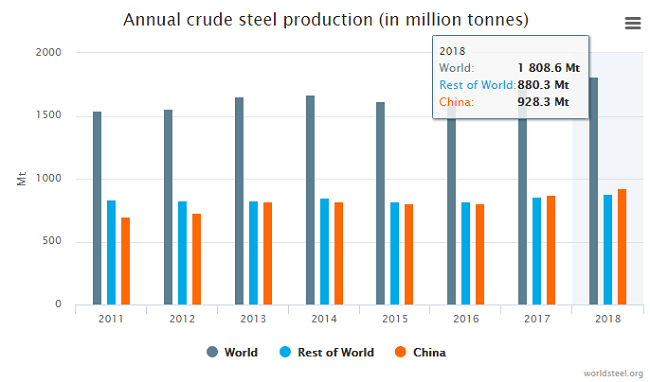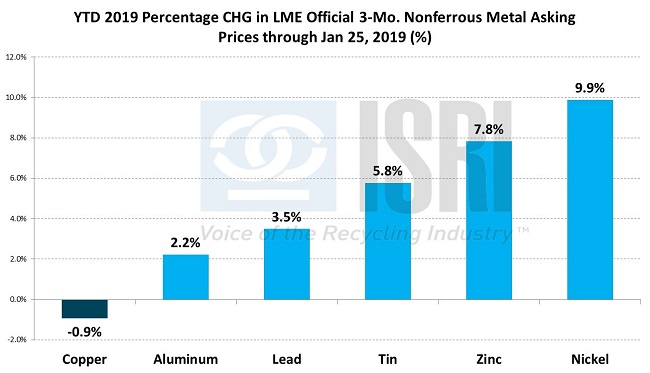Ferrous – Fastmarkets AMM reports that their “daily US Midwest hot-rolled coil index was at $34 per hundredweight ($680 per ton) on Thursday, down by 0.1% from $34.04 per cwt one day prior.
The last time the HRC price in the United States was this low level was on January 17, 2018, when it hit $33.98 per cwt.” One market participant points out that that: “We’re in an oversupply situation. Each offer I get is lower than the last one. I don’t think people are going to want to buy real big on anything.”
Seaborne iron ore prices dropped below $75 per metric ton (CFR) to China on Jan 22. Many offers on the market went unbid. A trader pointed toward Chinese mills being fully stocked in anticipation of the Lunar New Year throwing caution to the wind for potential losses in continuing to ship to China at this point.
Shredded auto scrap prices bumped up in Nov and Dec but with the decline in steel prices, 2019 prices appear to be off to a slower start. The Steel Market Development Institute (SMDI), a unit of AISI, recently published a series of reports that compared the greenhouse gas (GHG) emissions from Chinese and U.S. steel production. These peer-reviewed reports show that Chinese production of hot-dip galvanized steel coils produced 50% more GHG emissions than U.S. steel. This may push China towards converting more of their steel-making capacity towards EAF steel production and increase their demand for ferrous scrap as they have commitments to the Paris Climate Accords to achieve.
According to the World Steel Association, China produced 928.3 million tons of crude steel in 2018, an increase of 6.6% over 2017. Worldsteel also reports that steel production in 2018 increased 6.2% in the U.S. to 86.7 million tons, was up 4.9% in India to 106.5 million tons, was flat in Europe at 311.8 million tons, and decreased 0.6% in Turkey to 37.3 million tons.

For the week ending January 19, AISI reports that domestic raw steel production was 1,912,000 net tons while the capability utilization rate was 80.7 percent. Production was 1,715,000 net tons in the week ending January 19, 2018 while the capability utilization then was 73.6 percent. The current week production represents an 11.5 percent increase from the same period in the previous year. Production for the week ending January 19, 2019 is up 1.1 percent from the previous week ending January 12, 2019 when production was 1,891,000 net tons and the rate of capability utilization was 79.8 percent.
Nonferrous – Last week, Reuters reported “China’s December scrap metal imports rose to their highest level since May at 510,000 tonnes, data from the General Administration of Customs showed on Friday, as traders dashed to bring in shipments before China further tightens waste imports in 2019. Arrivals of scrap copper last month rose to 250,000 tonnes, the highest since December 2017, from 220,000 tonnes in November, customs data showed. Scrap aluminum imports also increased in December, up to 150,000 tonnes from 130,000 tonnes in the previous month, the highest since March. For the full year of 2018, China imported a total of 5.34 million tonnes of waste scrap metals, customs data showed.”
For the year-to-date, it may surprise some that nickel prices have had the best performance thus far at the London Metal Exchange. As compared to the end of 2018, the LME official 3-mo. asking price for nickel was up nearly 10% to $11,785 per metric ton as of Jan 25, up from $10,725/mt at the end of 2018.

The worst performer among the major base metals so far this year has actually been copper, with the LME official 3-mo. asking price for copper down nearly 1% as compared to the end of 2018 to $5,925.50/mt as of last Friday. Even still, the International Copper Study Group reported last week that the “World refined copper balance for the first ten months of 2018 {including revisions to prior reports} indicates a {copper supply} deficit of about 545,000 tons.”
Meanwhile, Macquarie Research reports that “Our latest China copper survey shows continued divergence in industry sentiment on 3M copper market, and a seasonally-driven demand decline among fabricators and traders, led by lower demand from construction and transportation while power grid spending is rebounding strongly. Traders expect slower demand into next month thus their restocking interest has faded, while smelters reported a higher capacity utilisation rate this month. Smelters concentrate inventory slightly picked up, and they still have plans to restock concentrate as inventory is still low compared with history.”
Paper and Plastic – The story this week for paper and plastics appear to be a clash between local and state governments taking aim at what appears to them as an environmental issue and more attempts to prop up a weakened market that could be hammered by new regulations. Washington’s state legislature has a new bill in the pipeline to create an extended producer responsibility program for plastic packaging. Producers would have to participate in an approved plastic packaging stewardship organization in order to sell or distribute plastic packaging in WA. The proposed bill puts the onus onto the packaging producers to pay for “all administrative and operational costs” which includes sorting, reprocessing, and marketing. This may create a price floor and ceiling for plastics as their operations will likely see a flattened revenue stream from the program. However, it would incentive consumers to drive down prices. There’s an additional component to the bills that would set minimum post-consumer content for packaging products that may counteract such shift in cost burden.
A lawmaker from San Francisco has introduced legislation into the state legislature to forbid automatic paper receipts. As Adam Minter points out in his opinion piece at Bloomberg, this is a low-impact campaign that is diverting attention from more serious issues in environmentally-impactful recycling. There appears to be a data sample being touted on the environmental impact of the production of receipt paper in the U.S. However, the presumptions and estimates in the article are questionable and do not track accurately to the production patterns of the U.S. paper making industry.
For more information, please contact ReMA Research Analyst Bernie Lee.
Back to Main